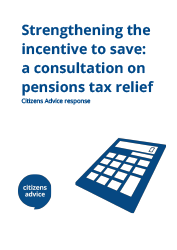Strengthening the incentive to save: a consultation on pensions tax relief
 In Strengthening the incentive to save: a consultation on pensions tax relief [ 0.55 mb], we explain our belief that the current system of exempt-exempt-taxed (EET) offers the best long-term results for individuals and the state. During accumulation, it offers a tangible reward for putting money aside and during decumulation it offers a healthy deterrent from withdrawing all savings at once.
In Strengthening the incentive to save: a consultation on pensions tax relief [ 0.55 mb], we explain our belief that the current system of exempt-exempt-taxed (EET) offers the best long-term results for individuals and the state. During accumulation, it offers a tangible reward for putting money aside and during decumulation it offers a healthy deterrent from withdrawing all savings at once.
The alternative tax-exempt-exempt (TEE) proposal lacks these benefits and would complicate the system for many. It would mean that state and private pensions had different tax treatment and could create intergenerational imbalances if people don’t pay any tax on their income in retirement.
However, we believe that the design of the current TEE system needs reform. Currently it mainly offers incentives for higher rate taxpayers and gives a large public subsidy for a minority of people who make pension savings well beyond a simply ‘adequate’ level.1 The focus of reform should be to encourage more people to save for an adequate income in retirement.
Moving to a flat rate tax relief of, say, 33% would be an improvement on the current system. It would increase rewards for basic rate taxpayers while ensuring that higher rate earners are not taxed more for paying into pensions than taking money up front as income. However, we question how much this reform would in itself drive changes in behaviour to deliver genuinely adequate incomes in retirement.
Long-term reform should consider more ambitious options and a focus on adequacy in saving leads to two major questions. First, is enough being done to encourage people to move beyond auto-enrolment levels? And second, is enough being done to encourage those not eligible for auto-enrolment to save?
Hard-working self-employed people, part-time workers and carers all lack access to the new system and are not adequately encouraged to save. We know for example that just 2.2% of tax relief on contributions go to the self-employed, even though they represent 15% of the workforce.2
These questions should be placed at the heart of further analysis and discussion. We recommend that the government considers a more generous incentive to encourage people to move towards minimal ‘adequate’ savings. It could use tax relief to extend the ‘incentive zone’ so people move beyond existing auto-enrolment contributions.
For example, it could offer a £1 match for every £1 put in (i.e. 50% tax relief) on contributions up to 1% above auto-enrolment levels. This would offer an incentive for employees with auto-enrolment to increase their contributions beyond the minimum, such as from a total of 8% to 10%.
It would also give the self-employed and part-time workers a ‘kick start’ to a savings habit and reward carers for continuing pension saving when they return to work.
We make the following recommendations:
-
The fundamental approach of the current EET system should be preservedbut can be better focused to improve its incentive effects.
-
A flat rate (of 33% for example) would be a modest improvement. It would increase returns for basic rate taxpayers saving into a pension and would create a simpler system with a common rate of relief.
-
However, a more ambitious approach should be taken to ensure that tax relief offers people more incentive save for an adequate income. We suggest the government should use tax relief to extend the 1:1 matching zone to encourage people to move beyond their existing auto-enrolment contributions.
-
The language around tax relief should be made clearer - any new system should be branded as a ‘matching contribution’ or ‘government pension bonus’ rather than being known as tax relief. If it is not easily understood, changes to tax relief will have limited effect. The government and industry should also help people understand how much they need to save, either through a dashboard system or prominent rules of thumb.
The government should seek to build consensus on purpose of tax relief and incentives for retirement saving to achieve lasting and sustainable reform. This could be used to set a reasonable level for annual and lifetime allowances to allow people to plan with more confidence.
1. The PPI estimated in 2013 that basic rate taxpayers pay 50% of pension contributions but receive only 30% of tax relief, while additional rate taxpayers make 10% of contributions and receive 20% of relief. See PPI, ‘Tax relief for pension saving in the UK’, 2013.
2. They get £600m out of a total £27bn on private pension contributions. ONS Personal Pensions Statistics, p.25, September 2015.

